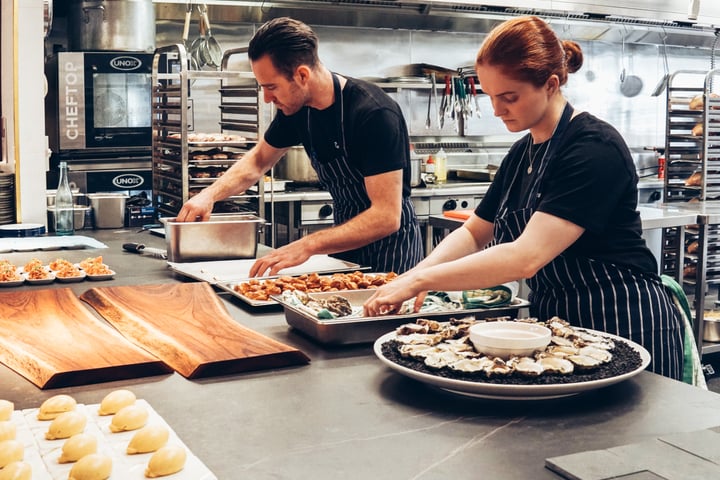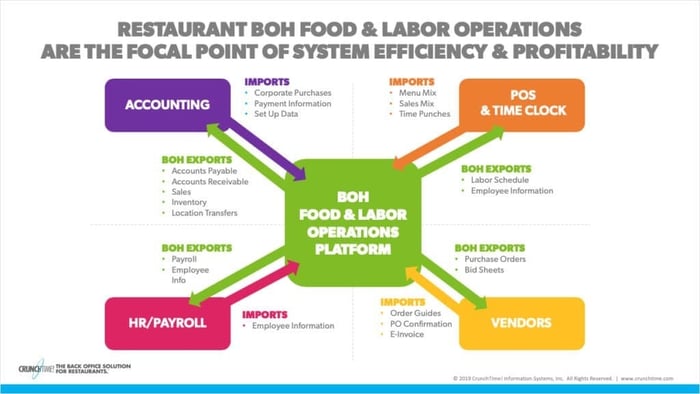
- Home
- Crunchtime Blog
- Building the Ideal Restaurant Back Office Technology Ecosystem

Building the Ideal Restaurant Back Office Technology Ecosystem
Here's why food and labor operations are the heart and soul of your restaurant technology stack.
The performance of your restaurant technology plays a large role in the success of your operations. After all, a winning restaurant manages to optimize their food and labor costs while providing the highest quality guest experience that keeps people coming back for more. Your tech stack is central to this formula. With the restaurant industry always in a state of flux, your technology needs to keep up. So what does the ideal back office technology ecosystem look like?
An Impulse For Tech Stack Consolidation
There is a natural impulse to consolidate. People love their smartphones because they combine communication and media consumption on one device. That impulse that sways us as consumers also impacts business decisions. That’s why a growing number of technology providers offer a suite of interconnected applications. Many businesses like this because it's convenient. While convenience should be factored into your restaurant technology investment strategy, so should the fact that your restaurant's technology needs are constantly changing.
Is Technology Vendor Consolidation Actually the Answer?
Not exactly – at least, not always. There are arguments against consolidation. Ultimately, consolidating multiple systems from one provider often affects features, functionality, and performance. Here are some reasons why:
- Vendor Resource Allocation - It’s simple math. Organizations have a finite amount of resources they can allocate to develop critical systems. An accounting system developer that does nothing but accounting systems will pool all its resources into making the best accounting system possible. A developer that builds ten applications – one of which happens to be accounting – has to allocate resources to make everything fit.
- Vendor Experience - We've all heard the saying... "Jack of all trades, master of none." This absolutely holds true with restaurant technology vendors and their talent pool. It is impossible to have a single point of contact for your technology vendor that understands all of the business nuances of POS, food and labor, HR and payroll, and accounting systems. Your time is valuable. When you do have to talk with your technology system provider, you need answers quickly. It's important that they are experts in 100% of the services they provide.
- Vendor Risk Management - Additionally, there's a heightened risk factor. If one provider delivers all critical business systems, and the restaurant decides its POS, food, and labor, or accounting system isn't meeting its needs, it often means it has to replace everything. Keeping some of these systems separate allows restaurants to replace only what isn't meeting their needs.
When FLO Consolidation is the Right Choice
Some areas within the restaurant are so intertwined that consolidation is the only sensible answer. In these instances, no level of integration between disparate systems can achieve the level of operational efficiency you need to maximize your investment into that technology. The most prominent case is your boh-flo. What's your boh-flo? It's the combination of your back of house food and labor operations.
The two biggest cost centers at your restaurant are food and labor. In short, food and labor are your restaurant's operations. Restaurant success is achieved when food and labor operations (cost, efficiency, quality) are optimized. The two are directly correlated via sales forecasting and planning – if you’re selling more food, that means your restaurant is busier and you need more people to handle the rush.
"At the end of the day, your restaurant’s success is contingent upon how well you manage and control the costs, efficiencies, and quality of your food and labor operations. Nobody wins the restaurant game because of their accounting system."
When your restaurant can identify how much was spent on food and labor versus how much should have been spent, it can optimize costs. It becomes easier to identify these variances when the day-to-day understanding of labor and food costs is available in a single platform in a single version of the truth. When everyone is on the same page regarding food and labor operations, the restaurant wins.
The Bottom Line
So let’s go back to the initial question – what does an ideal back office technology ecosystem look like? You start with the best possible food and labor operations platform. You cannot afford to consolidate technology with food and labor operations. It's simply too important for your business from a cost, efficiency, and quality perspective.
That said, you want a quality HR and payroll system. You want a quality POS system, too. At the center of the stack is a food and labor operations platform that integrates seamlessly with all the best possible POS, HR and payroll, and accounting systems. This will ensure you have the best possible solutions for every area of your business.
Share this post
Related


Teamwork Builds the Best Restaurant Software


